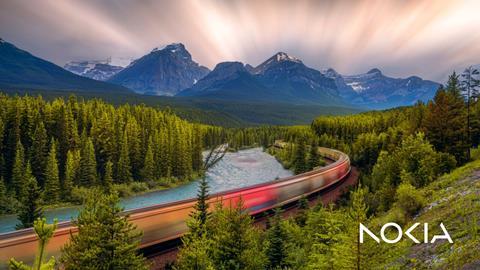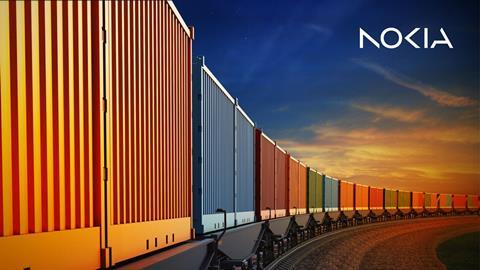How OT cloud networks deliver an AI-powered future

Railway operations are complex. Whether you’re moving freight or people, trains need to run reliably, safely and on time. As operations become increasingly digital, we are collecting ever more data — data that can be used to make more informed decisions and further boost efficiency, safety, reliability and sustainability. Artificial intelligence (AI) opens up even more possibilities for ways to use that data effectively. But to take full advantage of the possibilities, railway operators need to take a closer look at their networks and data centers.
We spoke to Nokia’s Houman Modarres, Head of Enterprise Marketing for Network Infrastructure, to get his thoughts on what the future of AI for railways looks like and what operators need to do to get ready.
What kind of impact do you see AI having on railway operations?
AI’s biggest impact will be in its ability to accelerate the pace and quality of decision-making. Right now, decisions are most often made reactively. For example, if a component in an engine breaks, you react by replacing it. AI can help address those conditions proactively, recognizing how much stress that component has been subject to and for how long, and correlating that with the component’s known life expectancy. So maintenance teams get alerted that the piece is due for replacement and they take care of it before it breaks and impacts the safety and comfort of passengers.
The benefits go far beyond predictive maintenance. AI is great at taking a tremendous pool of real-time, historical and contextual data points and correlating them to improve the quality of complex decisions. Take, for example, optimized scheduling and forecasting of passenger demand. In many cases, the organization has the data collected, but is not yet automating the correlation of the data effectively to make sense of how seemingly unrelated things might actually be related.
AI can parse data repositories (so called ‘data lakes’), make sense of the information, decide what to do with it and then act — much, much faster than humans can. There’s just too much to look at, too much to understand without our abilities being augmented by AI. Computers don’t take breaks, they don’t get overwhelmed, and they don’t forget. They can just crunch the numbers and, based on historical knowledge of the area, weather patterns, track and train conditions, and so on, recommend the best path forward. It’s basically a massive “operations assist” leveraging compute resources.
This all leads us toward the ultimate goal of intelligent, automated operations, both on the tracks and in the railyards. By supporting a higher degree of intelligence across all aspects of a railway, AI can help rail operators make trains safer, more reliable, efficient and sustainable, delivering a better passenger experience.

How is AI currently being used by railways?
The short answer is very carefully. There is a lot of interest, but right now, most AI use cases are still in the early proof-of-concept or evaluation stages. Operators are testing potential applications with plenty of human oversight, but there are some really promising pilot projects in progress.
One rail operator in the UK is testing an AI solution to detect and identify scrap material left at the side of tracks from previous maintenance or other work. The scrap can block pathways and present a tripping hazard — particularly as a lot of track maintenance is done at night. In the worst cases the debris can slide onto the tracks themselves, risking train damage or derailment. Using video recorded from the front of the train, the AI system analyzes footage to identify potentially hazardous piles of scrap material and notes their precise locations so they can be safely removed.
In another test project, a rail operator in Europe is looking to predict delays, using advanced algorithms to analyze historical train data in correlation with weather forecasts and other data points. This will increase their ability to plan and communicate, ultimately making their service more reliable.
In the US, a freight railway operator is deploying a combination of high-speed trackside cameras, stadium lighting and AI to create 360-degree images of moving railcars. This enables the operator to inspect rolling stock for potential defects and further increase operational safety.
Finally, another rail operator is testing an autonomous obstacle-detection system that can spot objects on the track at much greater distances than train drivers can. This creates a kind of “spidey sense” for drivers, allowing them precious extra time to react to potential hazards before they impact operation, making the overall system safer.
What barriers need to be overcome to move forward with full-scale AI solutions?
The biggest challenge is putting compute and network capacity in all the right places. AI requires a huge amount of data processing and compute power. Systems need to be able to collect data, send it to a data center, process it and make a decision, then send the information back — all fast enough to apply the decision while it is still useful. Addressing this challenge will require action on two fronts: in data centers and across the field area network.
What do railway operators need to do to prepare their data centers for AI?
Data is typically stored in what are referred to as “data lakes”. These are repositories of all kinds of data that AI can draw on to optimize outcomes. But they’re like real lakes in a way: if you want to go fishing in them, they need to be properly stocked. For data lakes, that means more kinds of sensors and devices in more places to collect more data, from infrared CCTV cameras to environmental sensors to traffic flow monitors. But all that data demands more computing power and memory, straining data centers like never before.
Historically, railway data centers have been built to handle IT applications. They weren’t being called on to support operational technology (OT) applications and assist in real-time decision making, so it was not necessarily considered mission-critical and designed for OT. But increased digitalization and advances in networking technology mean that railway operators can confidently adopt new data center technologies that let them achieve greater speed and agility without sacrificing reliability and stability.

What do railway operators need to do to prepare their networks for AI?
The migration of OT applications and data to the OT cloud, combined with the ease of getting more sensors out there in more places to collect more data, will stock up their data lakes and consume compute resources. But none of that will do you any good if you can’t get the data to and from your data centers fast enough to be of use. And that requires the right network.
While every railway operation has similar needs in terms of safety, reliability, and customer experience, different types of railways (metro vs. mainline passenger vs. freight) will require different network solutions in different locations (stations vs. track-side) to best meet their operational needs. For a train station or rail depot, a modernized local area network would deliver the connectivity that is required, while a 4G/5G wide area network will better serve a metro train on the move. Mainline railways likewise benefit from broadband wide area networks and are currently experiencing a transition from 2G to 5G. The Future Railway Mobile Communication System (FRMCS) is built on 5G and is designed to serve as a global standard to enhance railway broadband wireless communications, especially for mainline railways at this point.
In any case, a robust backbone network is required to ensure the data collected trackside, in stations or rail depots reliably and securely reaches its destination point in the data and operations and control center.
What are the security considerations when using AI?
Railways are mission-critical infrastructure and must be secured accordingly as they digitalize more of their operations. As digitalization and the use of AI grow, so does the attack surface that needs to be secured. A key piece of that is the recognition that digital assets are now an integral part of the infrastructure and are just as vital to operations as rolling stock and other physical assets. And just as those assets need to be secured against theft, damage and other hazards, the digital assets that now control and manipulate operations need to be protected as well.
When it comes to AI and security, you can look at it two ways. The rise and sophistication of AI brings with it new forms of security risks, from undermining AI models with false data to autonomous AI-powered cyberattacks on mission-critical systems. But operators can use AI in their own security strategy too. AI-enabled cybersecurity solutions can help with intrusion monitoring, detection and remediation, and empower security teams to be more proactive in anticipating and preparing for attacks in advance.
It’s also important to look ahead when planning a railway’s security strategy. The impending rise of quantum threats calls for new approaches to security that will protect against the challenges of today and those of tomorrow. A quantum-safe defense-in-depth approach will provide multiple levels of protection from optical transport to the IP edge to the application layer.
What are you most excited about when you look ahead to the future of railway operations?
I’m really looking forward to seeing all the ways we can leverage communications technology to drive better outcomes. AI has the potential to take applications we’re already using and turn up their effectiveness to 11, and turbo-charge the development of entirely new applications based on novel combinations of data sets that can deliver capabilities and outcomes we haven’t even considered. I can’t wait to see how this shapes the future of railway transportation.



















